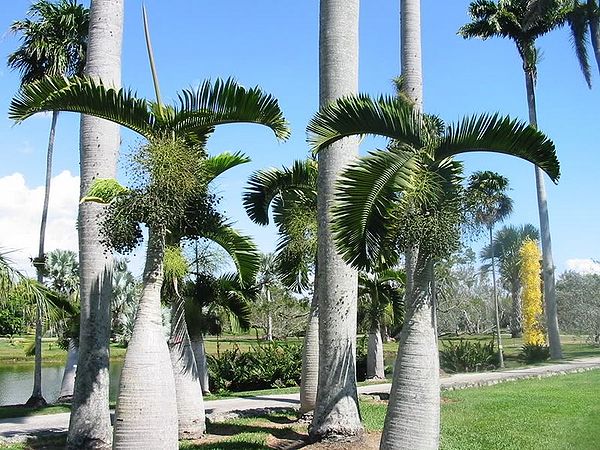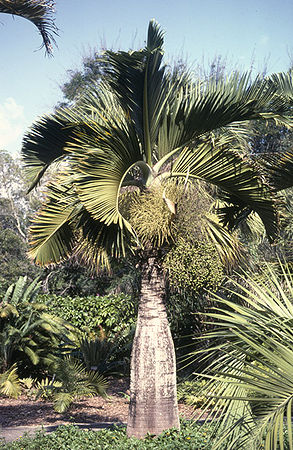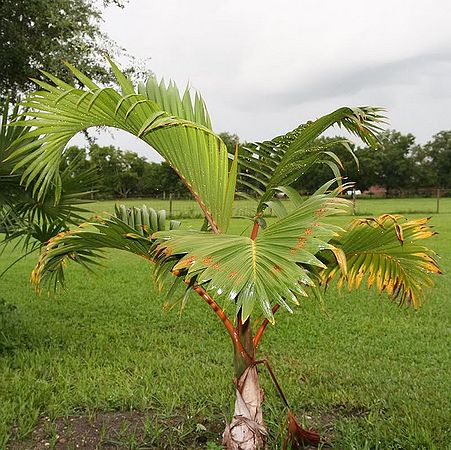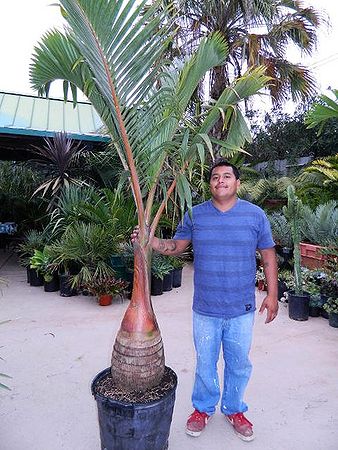Hyophorbe lagenicaulis
| Hyophorbe (hy-oh-FOR-beh) lagenicaulis (lahg-en-ih-KAW-lis) | ||||||||
|---|---|---|---|---|---|---|---|---|
 Fairchild Tropical Botanic Garden, Coral Gables, Florida. Photo by Kathryn Morgan | ||||||||
| Scientific Classification | ||||||||
| ||||||||
| Synonyms | ||||||||
|
| ||||||||
| Native Continent | ||||||||
|
| ||||||||
| Morphology | ||||||||
| ||||||||
| Culture | ||||||||
| ||||||||
| Survivability index | ||||||||
|
| ||||||||
| Common names | ||||||||
|
| ||||||||
Contents
Habitat and Distribution
Mascarene archipelago; Mauritius Islands. Endemic to Round Island. It naturally inhabits well-drained sandy soils of upland forests and coastal savannas.Description
This little dwarf of a palm will grow slowly to a height of 10-12 ft (3.1-3.7 m). The solitary trunk is grotesquely swollen and looks as if it were cast in smooth grey concrete. The trunk is a rounded bulge in young specimens and gradually elongates and flattens somewhat as the palm matures. These oldtimer bottle palms can be seen at Miami's Fairchild Tropical Garden. A small crown consisting of 4 to 8 pinnate (feather-like) leaves sits atop a smooth green crownshaft that connects the leaves to the trunk. The upwardly arching leaves grow to about 10 ft (3.1 m) in length in mature specimens. Leaflets are about 2 ft (0.6 m) long and arranged in two upward pointing rows. The inflorescences emerge at the point where the crownshaft meets the trunk. They grow upward as they mature supporting numerous male and female small white flowers on the same stalk. The female flowers are followed by 1 in (2.5 cm) round fruits which change from green to black as they mature. Hyophorbe lagenicaulis has a single trunk up to 20 ft (6 m) tall, about 2 ft in diameter with ring scars and green crownshaft at the top. The gray, self-cleaning trunk is bottle shaped, hence the name Bottle Palm. The Bottle Palm has a small crown of 4-6 4 to 8 pinnate, or feather-like, leaves that can grow up to 10 ft. It has 140 leaflets arranged in two upward pointing rows which grow to about 2 ft long. Flowers/Fruits: The Bottle Palm produces beautiful white flowers that are held by 30 in. stalks coming from below the crownshaft. Flowers are monoecious, male and female flowers on the same inflorescence. Flowers are followed by green black berry like fruits that turn black when ripe. Oval shaped fruit is around 1.5 inches long and contains a single seed inside. (floridata.com) Editing by edric.
This tree is slow growing but can reach heights that range from 12 to 20 feet. It grows best in full sunlight but can tolerate moderate shade. The pinnately compound leaves or fronds can grow to 12 feet long and are attached to a 10-inch petiole or stem. Its slender, lance-shaped leaflets are dark green, approximately 2 feet long, and grow opposite from one another to form a "V" shape on the rachis or middle of the frond. The trunk is smooth, light gray to almost white, and when young has a noticeably swollen base that becomes less pronounced and elongated as it matures. On top of the trunk sits a bright green crownshaft (from which the fronds emerge) that has a smooth, waxy surface and can reach 2 to 3 feet in height. Heavily branched flower inflorescences encircle the trunk just below the crownshaft and can reach lengths of 3 feet. Male and female flowers occur on the same inflorescence and are white or cream colored. Fruits are one inch in diameter and turn from green to black as they ripen. (edis.ifas.ufl.edu)
Culture
Growth Rate: Slow. This is a slow growing palm that can get up to 10 – 20 ft tall and 10 – 15 ft wide, but usually is much shorter around 10ft.
Outdoor/Indoor Use: Both. This palm can also be grown indoors in a container.
Cold Tolerance: Bottle Palm is not cold hardy and will not tolerate frost. It can handle temperature down to 30F. It is great for USDA Zones 10a (30 to 35 F) to 11 (above 40 F).
Light Req: This dwarf palm tree does well in filtered light, for best appearance. It can survive in full sun if provided plenty of water. Water Req: It can adapt to different kinds of soil but likes moist well drain soil.
Maintenance: Easy to maintain. Apply good quality palm fertilizer that has continues release formula twice a year during growing season.
Propagation: Bottle Palm is propagated by seeds. It takes around 5 – 6 months to germinate.
Comments and Curiosities
| read more |
|---|
|
Etymology: The genus name is Greek for “pig” and “food”, the allusion probably to the fruits being at one time used for fodder. The epithet is derived from two Greek words meaning “bottle” and “stem”. Conservation: 1998; On Round Island. Fewer than 10 mature trees remain in the wild. Regeneration is increasing since rabbits and goats were eradicated from the island. The island is a managed reserve. The Bottle Palm, from the Mascarene Islands, is a well-known and very popular ornamental for tropical, and warm subtropical regions. It produces a curiously swollen trunk, the shape of which is somewhat reminiscent of a champagne bottle. The crown holds up to five leathery, pinnate fronds supported by a slender, waxy crownshaft. The Bottle Palm grows fairly slowly but is a tough plant that can take drought and coastal conditions without a problem. (RPS.com) Hyophorbe lagenicaulis - Bottle Palm, is a tropical palm suitable for a smaller landscape, or as a large interior potted plant. Hyophorbe lagenicaulis - Bottle Palm - is an endagered species on its only known native home of Round Island in the Mascarene Island Group, Indian Ocean. Hyophorbe lagenicaulis has been saved from extinction by its popularity, and extensive cultivation throughout the world. The Bottle Palm's grossly enlarged base, its neat - tapering crownshaft and canopy, and its slow growth, have made it a most desirable palm for both landscape and interior displays. A dainty, neat palm, growing only to 12 feet, with a bottle-shape trunk which is widest at the base, tapering upwards to the neck of the bottle formed by the crownshaft. The canopy is sparse with only 4 to 8 leaves which are stiff, smooth and recurve on a small, 8 to 10 inch petiole. (anns tropics) The swollen trunk is the eye catcher on this palm, but it also has other interesting characteristics that come and go as the palm matures from a seedling to a mature specimen. As a seedling, and through the Bottle Palm's juvenile period, the crownshaft and leaf petioles are an interesting red to orange color, eventually changing to the normal greyish green color as it matures. As the Hyophorbe lagenicaulis - Bottle Palm passes from seedling to juvenile it starts to develop the huge, swollen trunk. In the early years, the trunk will swell more the the palm grows in height, making it look like a large ball with a neat little canopy. As the palm ages, it starts to elongate more than the trunks swells, giving it the bottle shape. During this whole period, the canopy gets larger with each successive growth until the leaves are 9 to 12 feet in leangth. Because this is a slow grower, it can take years for it to reach its mature height. (anns tropics) Hyophorbe lagenicaulis - Bottle Palm is truly a tropical palm. It loves tropical heat and is very salt tolerant. It cannot take any freezing temperatures, and will be severely damaged, if not outright killed by a hard frost. Any temps below 38 degrees call for protection for this palm. It is commonly thought that the swollen trunk is for the purpose of water storage. This palm however requires frequent watering during extended dry periods to look its best. Hyophorbe lagenicaulis - Bottle Palm also benifits greatly from giving it an application of a good slow release palm fertilizer that includes micronutrients 2 to 3 times a year. (anns tropics) |
- IMAGE GALLERY
External Links
References
Phonetic spelling of Latin names by edric.
Special thanks to Geoff Stein, (Palmbob) for his hundreds of photos.
Special thanks to Palmweb.org, Dr. John Dransfield, Dr. Bill Baker & team, for their volumes of information and photos.
Glossary of Palm Terms; Based on the glossary in Dransfield, J., N.W. Uhl, C.B. Asmussen-Lange, W.J. Baker, M.M. Harley & C.E. Lewis. 2008. Genera Palmarum - Evolution and Classification of the Palms. Royal Botanic Gardens, Kew. All images copyright of the artists and photographers (see images for credits).
Many Special Thanks to Ed Vaile for his long hours of tireless editing and numerous contributions.









































